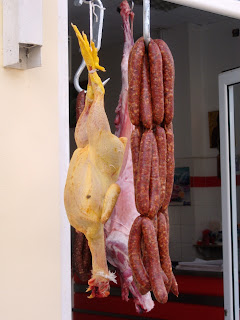.

Greek flag (with “Liberty or death” syllables added at right)
.
Why the Greek history lesson? During our 5-day Catholic/Protestant Easter holiday weekend (Orthodox Easter is one month later this year), a classmate – Shiva Beharrysingh from Trinidad – and I took a two-day excursion to the region of the northern Peloponnese, where Bishop Germanos supposedly made his symbolic proclamation at Agia Lavra monastery.
.
Although we chose a particularly appropriate time to visit the area – just a couple of days before national independence holiday – this wasn’t the main reason we chose to travel here. According to my Greek guidebook, there’s a nifty, old, rickety train (with a rack-and-pinion traction system), which makes a very steep ascent from Diakofto, passes through a dark tunnel, and provides spectacular views of the Vouraïkos Gorge along the “Diakofto-Kalavryta Railway”. The one-hour journey goes first to a tiny, remote mountain village called Zahlorou and then onward to a larger town called Kalavryta. I was looking forward to what sounded like a harrowing, rollercoaster-ish ride up the mountain with breathtaking views… but when we arrived in Diakofto and asked the railroad clerk where and when to catch the mountain train, he replied, in broken English: “Train closed. Come back October.”
.
Now what? We’d taken a 3-hour train ride from Athens to Diakofto specifically to ride this special train. When we checked for trains going from Diakofto to other interesting destinations later that day (it was already around 3:30pm), there were very few options. After some deliberation at a local bar, we decided to hire a taxi to take us up the mountain. After 30 minutes of haggling with a cabbie to lower the price from €35 to €30, we finally headed up the mountain. Without any real knowledge of where we were going, we decided to have him drop us in Zahlorou (instead of the larger Kalavryta). Our impression from my guidebook was that this was sort of a “halfway point” on the train ride and that it was possible to hike back down the mountain to Diakofto from here. We figured we would stay the night in Zahlorou and then hike back down the hill in the morning before catching a train back to Athens.
.
But nothing ever quite turns out like you expect… especially when you “wing it”, as we had, without any real plans, reservations, or prior contact with people at our final destination. When we arrived, we were pleasantly surprised by the quaint feel and small size (population: ~100) of Zahlorou. There were three inns/restaurants, 20-30 homes… and that was about it. The first inn had one available room – in marginal condition – that they offered for €40. Since this was €10 higher than the price listed in my guidebook (and since it’s the “low season”), I tried to bargain him down a bit. He was unwilling to bend, so we left. At the second place, the lady said she had only a room with one large bed for €50. Nope. Then we decided to try the nicer-looking place on the opposite hill. A guy named Maltos, who spoke English relatively well, told us that the rooms he had here on the hill were somewhat expensive (€100). But he had some other rooms 500 meters away (slightly outside the village limits) that he would rent for cheaper. We went to see the cheaper rooms and were pleasantly surprised – nice, clean, modern rooms for the same price (€40) that the first guy had asked for the cruddier room. We took Maltos’ offer.
.
The village – dissected by a small creek and parallel railroad tracks – is surrounded by rocky, mountainous terrain, which is perfect for hiking and free-climbing. After some exploring in the adjacent hills until dusk, we headed to Maltos’ restaurant and had a nice Greek dinner. In the morning, we got up early-ish (7:30am) and did some more hiking of the countryside. We’d learned that the out-of-commission train still runs from Zahlorou to Kalavryta, so we went for breakfast and planned to catch the 11am train up the hill. At the restaurant, our waitress didn’t speak a word of English, so a mid-20s couple sitting at the adjacent table translated for us. Then we got into a conversation with the couple – Georgios and Maria – and they offered to give us a ride in their car to Kalavryta. We accepted. They were very friendly and generous and ended up taking us with them to visit not only Kalavryta but also the Agia Lavra monastery, a monument to Greek independence on a neighboring hill, and a site called “Cave of the Lakes” (actually, I didn’t go to the cave, but Shiva did; I was concerned about returning to Athens as quickly as possible, because two out-of-town friends, Phil & Linn, were returning to Athens that evening from their island getaway to Aegina). Thanks to Maltos, Georgios, Maria, and the beautiful natural setting of Zahlorou, I had a really enjoyable trip. Here are some photos from our adventure:
.

Old locomotive engine display in Diakofto
.

Late afternoon view of village Zahlorou
.

From the mountainside near Zahlorou
.

Overlooking Zahlorou from Maltos’ family restaurant
.

Along the RR tracks between Zahlorou & Kalavryta
.

Maria, Georgios, me, & Shiva at famous Agia Lavra monastery
.

Statue of Archbishop Germanos with his legendary flag: “EΛEΥΘΕΡΙΑ ‘Η ΘΑΝΑΤΟΣ”
.

Monument to Greek independence near Agia Lavra
.

Nice view from independence monument
.

Kalavryta's main drag
.

Kalavryta from on high
.

Pretty Kalavryta church
.

Fresh meat in Kalavryta
